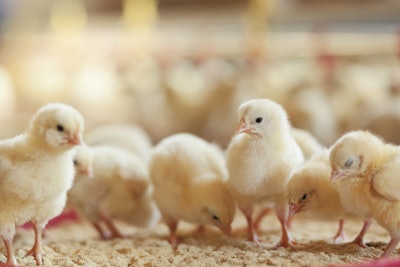
Reduced antibiotic use in poultry production increases the need for maintaining a healthy and functioning gut, and a key component of this is a balanced microbiota. There are a number of management practices that can favor the microbiota or work to its detriment, and reevaluating how we manage poultry flocks is becoming increasingly important as more producers adopt antibiotic-free production.
Vertical microbe transmission
When we try to manipulate the young bird’s microbiome, we cannot think of the bird in isolation, we need to take a holistic view, looking back to the breeder source.
When we think about the microbes inside a chicken or turkey, such as bacteria and fungi, we do not always contemplate where they originated, yet it has been long known that some of these organisms can be transferred vertically through the egg.
Salmonella, for example, is one of the negative microbes that can be vertically transmitted and is a major concern when it comes to food safety. However, more and more studies are indicating that good bacteria are also transferred vertically.
To establish a healthy microbiota for living organisms, we must think about nature vs. human interaction. In nature, an egg is laid, exposed to a natural environment, and microbes colonize its surface. Commercially, humans clean and disinfect eggs, removing microbes - good and bad - in the process.
Because, along with pathogens, we eliminate their competition -the beneficial microbes - through clean processes in a hatchery, it can take more time to control harmful bacteria, such as Escherichia coli and Salmonella, when problems do arise.
Can we be too clean?
Evidence shows that people who grow up on farms have fewer allergies and asthma than those from suburban areas or houses that tend to be cleaner.
When we’re born, we encounter many different microbes - it is up to our immune system to decide which are good and which are bad. The immune system can develop differently in humans exposed to “clean” environments than in those brought up in environments where fewer disinfectants are used.
In commercially-raised chickens and turkeys a similar situation arises. Typically, barns at the highest risk for disease are those where there are young birds and, often, they are thoroughly cleaned between flocks.
In turkey production, the brood barn supports turkey poults raised until about four weeks of age. Turkeys are then moved to the grow-out barn where they are raised for the rest of their lives.
Brood barns are typically extensively cleaned between flocks to eliminate harmful viruses and bacteria or to keep them at the lowest possible levels. However, in doing so, we may inadvertently be causing problems for a bird’s microbiome. In reducing environmental disease challenges we may, at the same time, be sacrificing the establishment of a healthy intestinal flora. A balance needs to be found between hygiene and supporting the development of a healthy microbiota.
This might mean not cleaning too much, but keeping pathogen loads low. Alternatively, products that may support the microbiome, such as probiotics, prebiotics, or yeast fermentation products, can be added to feed. These could, potentially, help to strengthen the gut microbiota in a chick, especially if a rich source of bacteria is not available in the chick’s environment.
Antibiotic reduction, resistance
If we compare the microbiome of a commercial turkey and a wild turkey, dramatic differences can be observed. This would suggest that commercial production has had a long-term impact on the turkey microbiome.
Some of these differences are, undoubtedly, attributable to the long-term use of antibiotics in commercial production. While individual turkeys may be short-lived, the same genetic stocks are used to grow millions of birds, so changes occurring at parent level will be felt across their progeny.
We might hope that the various antibiotic reduction campaigns being implemented around the world might result in the restoration of birds’ microbiomes to a more natural state, but this might not happen without help. It may be up to producers to facilitate this change through feed supplementation.
A similar situation may occur with antibiotic resistance. Creating it can happen quickly; reversing it, however, may take much longer. Resistance will eventually go down, but it will never disappear.
This, however, creates an opportunity, and we may be able target resistance and lower its frequency. Numerous technologies may be able to help with this, for example CRISPR technology.
Bacteria have developed CRISPR systems as natural “immune systems” to kill other microbes. To do this, they survey and collect pieces of DNA, allowing them to recognize and destroy other microorganisms.
Laboratory work has shown that it is possible to create bacteria strains that can target antibiotic resistant bacteria. If these laboratory strains could be delivered to the poultry house, or directly to the bird, they could target resistant bacteria, either inactivating or killing them. CRISPR, and similar technologies, are opening the door to reducing resistance at a faster pace than it would occur naturally.
A bird’s microbiome plays a key role in its health and we can modulate it through judicious management and product choices. Employing the latest management techniques and judiciously choosing which products we give our birds we can produce birds in an antibiotic-free environment without impairing human or animal health.

The environment can play an important role in aiding birds to develop a varied intestinal flora that may help in protecting them from pathogen challenge. sansubba | iStock.com

















